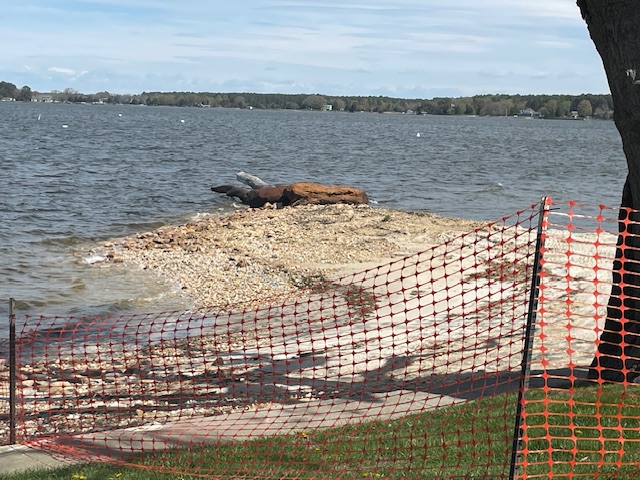
Please follow us on Gab, Minds, Telegram, Rumble, Truth Social, Gettr, Twitter
A comment made by a town commissioner Tuesday night revealed another truth behind the Oxford Strand Restoration Project.
The project is a test case so that the DNR, National Wildlife Federation, and the contractor, Underwood and Associates, can see if their approach of tearing up a shoreline, placing " living islands" at certain locations, and putting boulders and logs there will actually work in preserving the beach and preventing the erosion of sand.
Commissioner Katrina Greer, during a discussion about the "attractive nuisance" of the logs and boulders on the Strand, made the statement that the agencies would be "studying it (the Strand) until 2026" to see the effectiveness of this approach on the erosion of the shoreline.
It's something we have heard before. The problem is that many residents of the town weren't paying full attention. It was said during an information session about the project at the Oxford Community Center:
According to Nicole Carlozza from the DNR, Oxford came in with the project in 2019. (Minutes from town meetings indicate that Oxford began courting this solution on 1/23/ 2018.)
At any rate, DNR accepts bids for these projects based on criteria which include coastal exposure reduction, ecological enhancement, cost efficiency, wildlife benefits, social benefits, equity, local capacity to implement, DEMONSTRATION VALUE, community wide benefits, readiness and ability to proceed, and landowner participation. Carlozza said that the "town" asked DNR to pursue solutions including "living shorelines" to solve erosion and flooding on the Strand.
When you see "demonstration value" you should read, "experimental ."
Town Manager Lewis also said the same in an interview she gave to the National Wildlife Federation:
I also think that, because this site is so high profile and has so much public access, this living shoreline will serve as an example of how resilience projects can protect infrastructure while enhancing public access. Because our town is so highly visited, anyone can come here, look at our projects, and be able to utilize these techniques elsewhere.
If the techniques actually work. Based on recent observations, they might not.
Being an experiment for the DNR is not necessarily a bad thing, if people of the town are aware of it. Based on minutes from the meetings during which the project was discussed, it was never openly billed as a test case. Or maybe it was and the decision makers in town were not paying attention to exactly what was said.
Here are two sections of the town minutes from 1/23/18:
Administrator Lewis explained she was requesting a letter of interest to apply for design funds for green
infrastructure for the town’s shoreline areas, to include the Strand, the parking lot off the Strand, Lovers
Lane beach, and all of the town’s street ends, which potentially could use some green infrastructure to
improve resiliency and reduce erosion.
Even though no one knows what the best design would be right now, what is known is that the Strand is a historic beach and would need to be preserved as a sandy beach and the parking lot is used as a kayak access, but something is needed to add resiliency to the beach and protect the street and parking lot infrastructure. Lewis added that the National Wildlife Federation is looking for a community to collaborate with on a project in applying to the grant program, as the NWF is expanding their work on the preservation of shorelines and the use of green as opposed to gray infrastructure.
Note the bolded statements. The National Wildlife Federation was looking for a guinea pig. They found Oxford's government, a group that would accept the money to try this approach even if it wouldn't work.
The Commissioners at the time were Gordon Fronk, Gordon Graves, and John Pepe. Here is what they did when they heard the description of this project:
Commissioner Fronk made a motion to allow Administrator Lewis to prepare a letter of intent to apply to the community resiliency grant program to look at designing green infrastructure for the beach areas, the motion was seconded by Commissioner Pepe, all were in favor, and the motion carried.
The project was always discussed as a way to prevent erosion of the beach and flooding of the Strand and Strand Parking lot in order to protect "important infrastructure underground." Even the head architect of the project, Chris Becraft, said recently that the project would not prevent flooding of the Strand, Strand Parking lot, nor the Condominiums located off that road.
He also readily admitted to interested citizens who asked that he has NO experience creating the kind of parking lot they are now supposedly working on. If you look at the Underwood and Associates website, you will see they have created projects such as this in undeveloped spaces and private property, but never for a town:
Projects | Underwood (ecosystemrestoration.com)
Now, to adding to the fact that the project will not do what was promised by town leadership, we find out it is a "test case" for which DNR and NWF will be collecting data until 2026. One resident of the town has already been measuring the depth of the area of the water outside the beach and noted that the water has become considerably shallower and filled with more sand as time has elapsed. In other words, the sand is being taken off the beach into the Tred Avon River.
Question is, if this restoration DOESN'T work, who is left holding the bag? Has any Oxford citizen/taxpayer seen the contract for this project except for the Commissioners? Was anyone told this was an experiment?
Along with the question of whose left holding the bag if the project doesn't work, there's another question. Who is liable for any injury or damage caused any components of the project?
Components would be the huge logs and boulders at the end of the "living islands" that have been created.
Here is a picture of just a few of those logs and boulders:
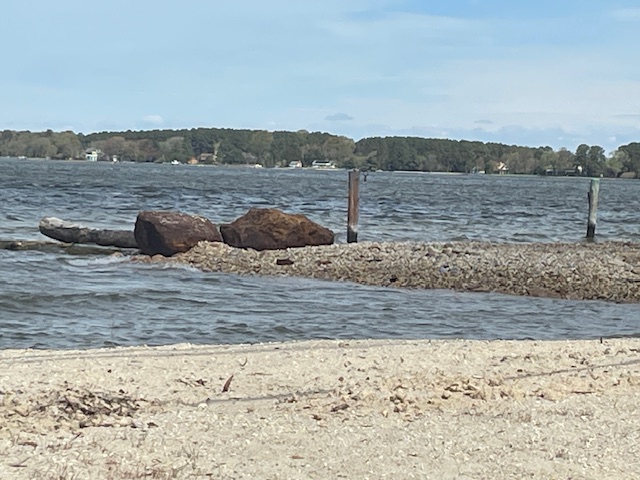
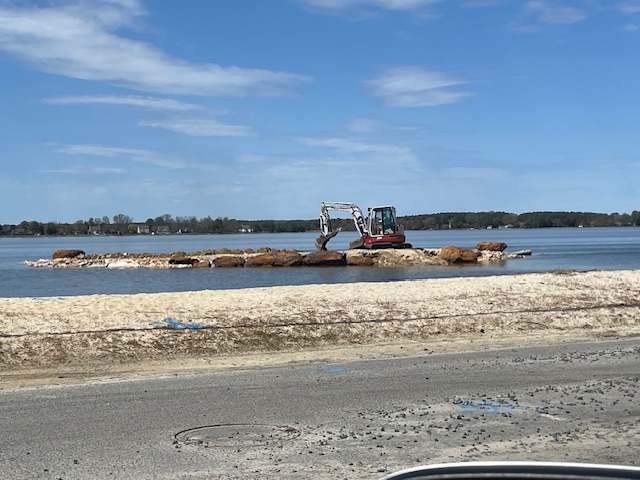
At the April 9th town meeting, one Oxford resident raised a concern about the safety of the huge logs and boulders that are part of the Strand Restoration Project. You see, logs and boulders may be fine on private property or on undeveloped shoreline, but they are a recipe for disaster when people come to a beach.
The citizen expressed concern because he first observed a waterdog on one of the log features of the project. The dog shredded his back paw on the log. He was trying to show a picture of the extent of the injury to President of the Commissioners Tom Costigan when Tom loudly asked, "Where was the owner?" He asked twice implying that the owner was negligent with his pet by not following leash laws with a dog that was swimming. * He was told the owner was "right there."
The citizen then relayed another scene; children at the end of the islands diving off the pole that was there. None of the kids were hurt, but the description inspired a discussion of the possibility of injury or harm to someone based on the "attractive nuisance" of the logs and rocks on the Strand.
Appointed Commissioner Botkin suddenly asked, "Where were the parents of the children who were jumping off? "She quickly added, "That was a rhetorical question."
A discussion began about the logs and boulders and whether they could be removed. Town Manager Lewis stated that the designer of the project did not recommend removing these features because it would impact the effectiveness of the design.
Town resident Susan Cordel responded by reminding Lewis and the Commissioners that, when the question about removing the logs and boulders came up at the Community Center session about the project, Becraft answered that these features had been requested by the town as "aesthetic" and they could be removed. He compared the logs and boulders to wearing a belt and suspenders, one can remove the suspenders without impacting the effectiveness of the belt.
A discussion ensued about preventative measures such as signs and fences to keep people off the islands.
Interim Chief of Police Chris Phillips shared that the berm that separates the beach area from the Strand Road obstructs the view of the beach from law enforcement. This could become a problem if someone was in distress on the beach or in the water.
The town was also reminded by a lawyer in the audience that since the issues regarding the logs and boulders have been brought up to the town, liability laws says the town will be liable for anyone who is injured while out there on the islands.
It's interesting that no one thought of these problems and how to handle them prior to the project going forward. Town Lawyer Lyndsey Ryan promised that the issue would be handled.
As of Friday, a construction fence has been placed on the Strand and there appears to be work on the islands. One friend says it looks like they are trying to make it look better. Some plantings have been made along the shoreline. It seems they are removing the logs and boulders.
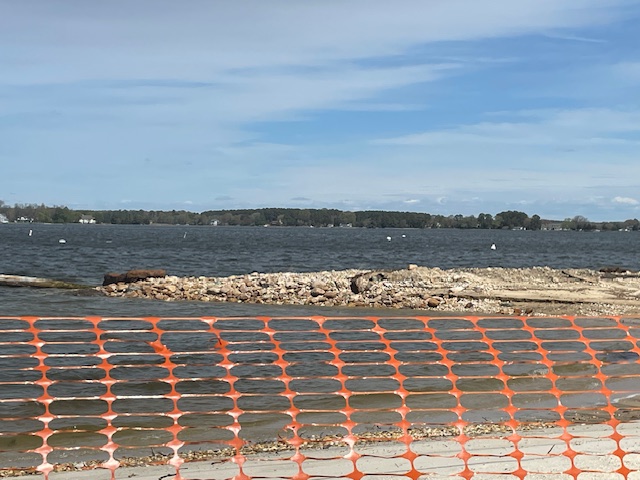
A construction fence now lines the Strand to prevent people from entering the beach area.
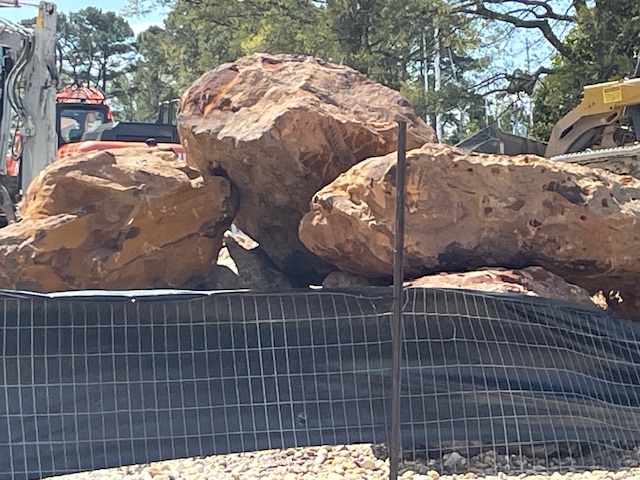
Large boulders from the islands in the parking lot across the street.
The problem is that this, just like many big experimental projects, possible problems and consequences are not always clearly thought out or presented. And, in an effort to get grant money, sometimes bureaucrats and elected officials don't examine the reality of what will happen if the grant doesn't give the desired result. In order to get "buy in" for officials/citizens, they don't always present all the facts either.
So, where do we go from here?
First, townspeople must be allowed to see all the paperwork associated with this project including the initial application for the grant, descriptions of design, responsibilities, and liabilities. Several local developers and contractors who do this kind of work expressed interest in the project and never got any response from the Town Office. Why? Why was the contract given to someone who is not local? Did the State mandate who the contractors would be? We need to see the list of every contractor who indicated interest and the reason they got no response. A project of this size and impact demands clarity and transparency.
We also need to know what happens if "restoration" DOESN'T work. Will DNR or NWF reimburse the town? Will they make it better? Will they fix it?
The Town website has many pictures and paragraphs as well as a couple of links (some that don't work) that help explain what is going to happen. There is no copy of the contract.
Oxford Shoreline Improvements – 2023 | Town Of Oxford, Maryland (oxfordmd.net)
Second, the methods for testing this project need to be made clear to the citizens of the town. What are the statistical benchmarks for success? What data will be collected and by whom? Will studies be done by an objective agency not connected to either the DNR or NWF?
Third, the people of this town need to know Oxford's ongoing responsibility for maintenance of the project and the projected cost of the maintenance. Will plants have to be replenished? Sand? We know from other beach replenishment programs that these costs could be formidable.
Finally, the Commissioners and the Town Office need to be forthcoming with answers when questions are posed. They need to stop stonewalling and refusing to answer questions. Questions are not a personal affront to them.
They also need to stop telling people involved with the project to NOT talk to citizens who ask questions. This approach is one that has NOT worked on this topic nor many others. It gives the appearance that something is wrong.
*We are not against leash laws. But, when dogs are swimming, leashes don't really work.
**Some will say the project is not "experimental." However, even the State doesn't completely buy in to this approach as the answer for situations like ours.
Hundreds Of Years Of Nature's Work Destroyed On Oxford Strand - Easton Gazette
Pictures Show Alarming Oxford Strand Erosion Despite "Restoration" - Easton Gazette